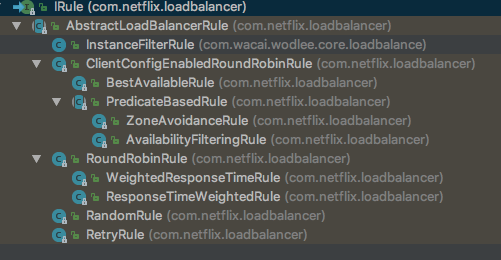简介
spring cloud ribbon 是一个基于http和tcp的客服端负载均衡工具,它是基于netflix ribbon实现的。它不像服务注册中心、配置中心、api网关那样独立部署,但是它几乎存在于每个微服务的基础设施中。包括前面的提供的声明式服务调用也是基于该ribbon实现的。理解ribbon对于我们使用spring cloud来讲非常的重要,因为负载均衡是对系统的高可用、网络压力的缓解和处理能力扩容的重要手段之一。在上节的例子中,我们采用了声明式的方式来实现负载均衡。实际上,内部调用维护了一个resttemplate对象,该对象会使用ribbon的自动化配置,同时通过@loadbalanced开启客户端负载均衡。其实resttemplate是spring自己提供的对象,不是新的内容。读者不知道resttemplate可以查看相关的文档。
现象
前两天碰到一个ribbon相关的问题,觉得值得记录一下。表象是对外的接口返回内部异常,这个是封装的统
一错误信息,spring的异常处理器catch到未捕获异常统一返回的信息。因此到日志平台查看实际的异常:
org.springframework.web.client.httpclienterrorexception: 404 null
这里介绍一下背景,出现问题的开放网关,做点事情说白了就是转发对应的请求给后端的服务。这里用到了ribbon去做服务负载均衡、eureka负责服务发现。
这里出现404,首先看了下请求的url以及对应的参数,都没有发现问题,对应的后端服务也没有收到请求。这就比较诡异了,开始怀疑是ribbon或者eureka的缓存导致请求到了错误的ip或端口,但由于日志中打印的是eureka的serviceid而不是实际的ip:port,因此先加了个日志:
|
1
2
3
4
5
6
7
8
9
|
@slf4j
public class customhttprequestinterceptor implements clienthttprequestinterceptor {
@override
public clienthttpresponse intercept(httprequest request, byte[] body, clienthttprequestexecution execution) throws ioexception {
log.info("request , url:{},method:{}.", request.geturi(), request.getmethod());
return execution.execute(request, body);
}
}
|
这里是通过给resttemplate添加拦截器的方式,但要注意,ribbon也是通过给resttemplate添加拦截器实现的解析serviceid到实际的ip:port,因此需要注意下优先级添加到ribbon的 loadbalancerinterceptor 之后,我这里是通过spring的初始化完成事件的回调中添加的,另外也添加了另一条日志,在catch到这个异常的时候,利用eureka的 discoveryclient#getinstances 获取到当前的实例信息。
之后在测试环境中复现了这个问题,看了下日志,eurek中缓存的实例信息是对的,但是实际调用的确实另外一个服务的地址,从而导致了接口404。
源码解析
从上述的信息中可以知道,问题出在ribbon中,具体的原因后面会说,这里先讲一下spring cloud ribbon的初始化流程。
|
1
2
3
4
5
6
7
8
|
@configuration
@conditionalonclass({ iclient.class, resttemplate.class, asyncresttemplate.class, ribbon.class})
@ribbonclients
@autoconfigureafter(name = "org.springframework.cloud.netflix.eureka.eurekaclientautoconfiguration")
@autoconfigurebefore({loadbalancerautoconfiguration.class, asyncloadbalancerautoconfiguration.class})
@enableconfigurationproperties({ribboneagerloadproperties.class, serverintrospectorproperties.class})
public class ribbonautoconfiguration {
}
|
注意这个注解 @ribbonclients , 如果想要覆盖spring cloud提供的默认ribbon配置就可以使用这个注解,最终的解析类是:
|
1
2
3
4
5
6
7
8
9
10
11
12
13
14
15
16
17
18
19
20
21
22
23
24
25
26
27
28
29
30
31
32
33
34
35
36
37
38
39
40
41
42
43
44
45
46
47
48
49
50
51
52
53
54
55
56
57
|
public class ribbonclientconfigurationregistrar implements importbeandefinitionregistrar {
@override
public void registerbeandefinitions(annotationmetadata metadata,
beandefinitionregistry registry) {
map<string, object> attrs = metadata.getannotationattributes(
ribbonclients.class.getname(), true);
if (attrs != null && attrs.containskey("value")) {
annotationattributes[] clients = (annotationattributes[]) attrs.get("value");
for (annotationattributes client : clients) {
registerclientconfiguration(registry, getclientname(client),
client.get("configuration"));
}
}
if (attrs != null && attrs.containskey("defaultconfiguration")) {
string name;
if (metadata.hasenclosingclass()) {
name = "default." + metadata.getenclosingclassname();
} else {
name = "default." + metadata.getclassname();
}
registerclientconfiguration(registry, name,
attrs.get("defaultconfiguration"));
}
map<string, object> client = metadata.getannotationattributes(
ribbonclient.class.getname(), true);
string name = getclientname(client);
if (name != null) {
registerclientconfiguration(registry, name, client.get("configuration"));
}
}
private string getclientname(map<string, object> client) {
if (client == null) {
return null;
}
string value = (string) client.get("value");
if (!stringutils.hastext(value)) {
value = (string) client.get("name");
}
if (stringutils.hastext(value)) {
return value;
}
throw new illegalstateexception(
"either 'name' or 'value' must be provided in @ribbonclient");
}
private void registerclientconfiguration(beandefinitionregistry registry,
object name, object configuration) {
beandefinitionbuilder builder = beandefinitionbuilder
.genericbeandefinition(ribbonclientspecification.class);
builder.addconstructorargvalue(name);
builder.addconstructorargvalue(configuration);
registry.registerbeandefinition(name + ".ribbonclientspecification",
builder.getbeandefinition());
}
}
|
atrrs包含defaultconfiguration,因此会注册ribbonclientspecification类型的bean,注意名称以 default. 开头,类型是ribbonautoconfiguration,注意上面说的ribbonautoconfiguration被@ribbonclients修饰。
然后再回到上面的源码:
|
1
2
3
4
5
6
7
8
9
10
11
12
13
14
15
16
17
18
19
20
21
22
23
24
25
26
27
28
29
30
31
32
33
34
35
36
37
38
39
40
41
42
43
44
45
46
47
48
49
50
51
52
53
54
55
56
57
58
59
60
61
62
63
64
65
66
67
68
69
70
71
72
73
74
75
76
77
78
79
80
81
82
83
84
85
86
87
88
89
90
91
92
93
94
95
96
97
98
99
100
101
102
103
104
105
106
107
108
109
110
|
public class ribbonautoconfiguration {
//上文中会解析被@ribbonclients注解修饰的类,然后注册类型为ribbonclientspecification的bean。
//主要有两个: ribbonautoconfiguration、ribboneurekaautoconfiguration
@autowired(required = false)
private list<ribbonclientspecification> configurations = new arraylist<>();
@bean
public springclientfactory springclientfactory() {
//初始化springclientfactory,并将上面的配置注入进去,这段很重要。
springclientfactory factory = new springclientfactory();
factory.setconfigurations(this.configurations);
return factory;
}
//其他的都是提供一些默认的bean配置
@bean
@conditionalonmissingbean(loadbalancerclient.class)
public loadbalancerclient loadbalancerclient() {
return new ribbonloadbalancerclient(springclientfactory());
}
@bean
@conditionalonclass(name = "org.springframework.retry.support.retrytemplate")
@conditionalonmissingbean
public loadbalancedretrypolicyfactory loadbalancedretrypolicyfactory(springclientfactory clientfactory) {
return new ribbonloadbalancedretrypolicyfactory(clientfactory);
}
@bean
@conditionalonmissingclass(value = "org.springframework.retry.support.retrytemplate")
@conditionalonmissingbean
public loadbalancedretrypolicyfactory neverretrypolicyfactory() {
return new loadbalancedretrypolicyfactory.neverretryfactory();
}
@bean
@conditionalonclass(name = "org.springframework.retry.support.retrytemplate")
@conditionalonmissingbean
public loadbalancedbackoffpolicyfactory loadbalancedbackoffpolicyfactory() {
return new loadbalancedbackoffpolicyfactory.nobackoffpolicyfactory();
}
@bean
@conditionalonclass(name = "org.springframework.retry.support.retrytemplate")
@conditionalonmissingbean
public loadbalancedretrylistenerfactory loadbalancedretrylistenerfactory() {
return new loadbalancedretrylistenerfactory.defaultretrylistenerfactory();
}
@bean
@conditionalonmissingbean
public propertiesfactory propertiesfactory() {
return new propertiesfactory();
}
@bean
@conditionalonproperty(value = "ribbon.eager-load.enabled", matchifmissing = false)
public ribbonapplicationcontextinitializer ribbonapplicationcontextinitializer() {
return new ribbonapplicationcontextinitializer(springclientfactory(),
ribboneagerloadproperties.getclients());
}
@configuration
@conditionalonclass(httprequest.class)
@conditionalonribbonrestclient
protected static class ribbonclientconfig {
@autowired
private springclientfactory springclientfactory;
@bean
public resttemplatecustomizer resttemplatecustomizer(
final ribbonclienthttprequestfactory ribbonclienthttprequestfactory) {
return new resttemplatecustomizer() {
@override
public void customize(resttemplate resttemplate) {
resttemplate.setrequestfactory(ribbonclienthttprequestfactory);
}
};
}
@bean
public ribbonclienthttprequestfactory ribbonclienthttprequestfactory() {
return new ribbonclienthttprequestfactory(this.springclientfactory);
}
}
//todo: support for autoconfiguring restemplate to use apache http client or okhttp
@target({ elementtype.type, elementtype.method })
@retention(retentionpolicy.runtime)
@documented
@conditional(onribbonrestclientcondition.class)
@interface conditionalonribbonrestclient { }
private static class onribbonrestclientcondition extends anynestedcondition {
public onribbonrestclientcondition() {
super(configurationphase.register_bean);
}
@deprecated //remove in edgware"
@conditionalonproperty("ribbon.http.client.enabled")
static class zuulproperty {}
@conditionalonproperty("ribbon.restclient.enabled")
static class ribbonproperty {}
}
}
|
注意这里的springclientfactory, ribbon默认情况下,每个eureka的serviceid(服务),都会分配自己独立的spring的上下文,即applicationcontext, 然后这个上下文中包含了必要的一些bean,比如: iloadbalancer 、 serverlistfilter 等。而spring cloud默认是使用resttemplate封装了ribbon的调用,核心是通过一个拦截器:
|
1
2
3
4
5
6
7
8
9
10
11
12
13
14
|
@bean
@conditionalonmissingbean
public resttemplatecustomizer resttemplatecustomizer(
final loadbalancerinterceptor loadbalancerinterceptor) {
return new resttemplatecustomizer() {
@override
public void customize(resttemplate resttemplate) {
list<clienthttprequestinterceptor> list = new arraylist<>(
resttemplate.getinterceptors());
list.add(loadbalancerinterceptor);
resttemplate.setinterceptors(list);
}
};
}
|
因此核心是通过这个拦截器实现的负载均衡:
|
1
2
3
4
5
6
7
8
9
10
11
12
13
14
|
public class loadbalancerinterceptor implements clienthttprequestinterceptor {
private loadbalancerclient loadbalancer;
private loadbalancerrequestfactory requestfactory;
@override
public clienthttpresponse intercept(final httprequest request, final byte[] body,
final clienthttprequestexecution execution) throws ioexception {
final uri originaluri = request.geturi(); //这里传入的url是解析之前的,即http://serviceid/服务地址的形式
string servicename = originaluri.gethost(); //解析拿到对应的serviceid
assert.state(servicename != null, "request uri does not contain a valid hostname: " + originaluri);
return this.loadbalancer.execute(servicename, requestfactory.createrequest(request, body, execution));
}
}
|
然后将请求转发给loadbalancerclient:
|
1
2
3
4
5
6
7
8
9
10
11
12
13
14
15
|
public class ribbonloadbalancerclient implements loadbalancerclient {
@override
public <t> t execute(string serviceid, loadbalancerrequest<t> request) throws ioexception {
iloadbalancer loadbalancer = getloadbalancer(serviceid); //获取对应的loadbalancer
server server = getserver(loadbalancer); //获取服务器,这里会执行对应的分流策略,比如轮训
//、随机等
if (server == null) {
throw new illegalstateexception("no instances available for " + serviceid);
}
ribbonserver ribbonserver = new ribbonserver(serviceid, server, issecure(server,
serviceid), serverintrospector(serviceid).getmetadata(server));
return execute(serviceid, ribbonserver, request);
}
}
|
而这里的loadbalancer是通过上文中提到的springclientfactory获取到的,这里会初始化一个新的spring上下文,然后将ribbon默认的配置类,比如说: ribbonautoconfiguration 、 ribboneurekaautoconfiguration 等添加进去, 然后将当前spring的上下文设置为parent,再调用refresh方法进行初始化。
|
1
2
3
4
5
6
7
8
9
10
11
12
13
14
15
16
17
18
19
20
21
22
23
24
25
26
27
28
29
|
public class springclientfactory extends namedcontextfactory<ribbonclientspecification> {
protected annotationconfigapplicationcontext createcontext(string name) {
annotationconfigapplicationcontext context = new annotationconfigapplicationcontext();
if (this.configurations.containskey(name)) {
for (class<?> configuration : this.configurations.get(name)
.getconfiguration()) {
context.register(configuration);
}
}
for (map.entry<string, c> entry : this.configurations.entryset()) {
if (entry.getkey().startswith("default.")) {
for (class<?> configuration : entry.getvalue().getconfiguration()) {
context.register(configuration);
}
}
}
context.register(propertyplaceholderautoconfiguration.class,
this.defaultconfigtype);
context.getenvironment().getpropertysources().addfirst(new mappropertysource(
this.propertysourcename,
collections.<string, object> singletonmap(this.propertyname, name)));
if (this.parent != null) {
// uses environment from parent as well as beans
context.setparent(this.parent);
}
context.refresh();
return context;
}
}
|
最核心的就在这一段,也就是说对于每一个不同的serviceid来说,都拥有一个独立的spring上下文,并且在第一次调用这个服务的时候,会初始化ribbon相关的所有bean, 如果不存在 才回去父context中去找。
再回到上文中根据分流策略获取实际的ip:port的代码段:
|
1
2
3
4
5
6
7
8
9
10
11
12
13
14
15
|
public class ribbonloadbalancerclient implements loadbalancerclient {
@override
public <t> t execute(string serviceid, loadbalancerrequest<t> request) throws ioexception {
iloadbalancer loadbalancer = getloadbalancer(serviceid); //获取对应的loadbalancer
server server = getserver(loadbalancer); //获取服务器,这里会执行对应的分流策略,比如轮训
//、随机等
if (server == null) {
throw new illegalstateexception("no instances available for " + serviceid);
}
ribbonserver ribbonserver = new ribbonserver(serviceid, server, issecure(server,
serviceid), serverintrospector(serviceid).getmetadata(server));
return execute(serviceid, ribbonserver, request);
}
}
|
|
1
2
3
4
5
6
7
8
9
10
11
12
13
14
15
16
17
18
19
20
21
22
23
24
25
26
27
28
29
30
31
32
33
34
35
36
37
38
39
40
41
42
43
44
45
46
47
48
49
50
51
52
53
54
55
56
57
58
59
60
61
62
63
64
65
66
67
|
protected server getserver(iloadbalancer loadbalancer) {
if (loadbalancer == null) {
return null;
}
// 选择对应的服务器
return loadbalancer.chooseserver("default"); // todo: better handling of key
}
public class zoneawareloadbalancer<t extends server> extends dynamicserverlistloadbalancer<t> {
@override
public server chooseserver(object key) {
if (!enabled.get() || getloadbalancerstats().getavailablezones().size() <= 1) {
logger.debug("zone aware logic disabled or there is only one zone");
return super.chooseserver(key); //默认不配置可用区,走的是这段
}
server server = null;
try {
loadbalancerstats lbstats = getloadbalancerstats();
map<string, zonesnapshot> zonesnapshot = zoneavoidancerule.createsnapshot(lbstats);
logger.debug("zone snapshots: {}", zonesnapshot);
if (triggeringload == null) {
triggeringload = dynamicpropertyfactory.getinstance().getdoubleproperty(
"zoneawareniwsdiscoveryloadbalancer." + this.getname() + ".triggeringloadperserverthreshold", 0.2d);
}
if (triggeringblackoutpercentage == null) {
triggeringblackoutpercentage = dynamicpropertyfactory.getinstance().getdoubleproperty(
"zoneawareniwsdiscoveryloadbalancer." + this.getname() + ".avoidzonewithblackoutpercetage", 0.99999d);
}
set<string> availablezones = zoneavoidancerule.getavailablezones(zonesnapshot, triggeringload.get(), triggeringblackoutpercentage.get());
logger.debug("available zones: {}", availablezones);
if (availablezones != null && availablezones.size() < zonesnapshot.keyset().size()) {
string zone = zoneavoidancerule.randomchoosezone(zonesnapshot, availablezones);
logger.debug("zone chosen: {}", zone);
if (zone != null) {
baseloadbalancer zoneloadbalancer = getloadbalancer(zone);
server = zoneloadbalancer.chooseserver(key);
}
}
} catch (exception e) {
logger.error("error choosing server using zone aware logic for load balancer={}", name, e);
}
if (server != null) {
return server;
} else {
logger.debug("zone avoidance logic is not invoked.");
return super.chooseserver(key);
}
}
//实际走到的方法
public server chooseserver(object key) {
if (counter == null) {
counter = createcounter();
}
counter.increment();
if (rule == null) {
return null;
} else {
try {
return rule.choose(key);
} catch (exception e) {
logger.warn("loadbalancer [{}]: error choosing server for key {}", name, key, e);
return null;
}
}
}
}
|
也就是说最终会调用 irule 选择到一个节点,这里支持很多策略,比如随机、轮训、响应时间权重等:
|
1
2
3
4
5
6
7
8
|
public interface irule{
public server choose(object key);
public void setloadbalancer(iloadbalancer lb);
public iloadbalancer getloadbalancer();
}
|
这里的loadbalancer是在baseloadbalancer的构造器中设置的,上文说过,对于每一个serviceid服务来说,当第一次调用的时候会初始化对应的spring上下文,而这个上下文中包含了所有ribbon相关的bean,其中就包括iloadbalancer、irule。
原因
通过跟踪堆栈,发现不同的serviceid,irule是同一个, 而上文说过,每个serviceid都拥有自己独立的上下文,包括独立的loadbalancer、irule,而irule是同一个,因此怀疑是这个bean是通过parent context获取到的,换句话说应用自己定义了一个这样的bean。查看代码果然如此。
这样就会导致一个问题,irule是共享的,而其他bean是隔离开的,因此后面的serviceid初始化的时候,会修改这个irule的loadbalancer, 导致之前的服务获取到的实例信息是错误的,从而导致接口404。
|
1
2
3
4
5
6
7
8
9
10
|
public class baseloadbalancer extends abstractloadbalancer implements
primeconnections.primeconnectionlistener, iclientconfigaware {
public baseloadbalancer() {
this.name = default_name;
this.ping = null;
setrule(default_rule); // 这里会设置irule的loadbalancer
setuppingtask();
lbstats = new loadbalancerstats(default_name);
}
}
|
解决方案
解决方法也很简单,最简单就将这个自定义的irule的bean干掉,另外更标准的做法是使用ribbonclients注解,具体做法可以参考文档。
总结
核心原因其实还是对于spring cloud的理解不够深刻,用法有错误,导致出现了一些比较诡异的问题。对于自己使用的组件、框架、甚至于每一个注解,都要了解其原理,能够清楚的说清楚这个注解有什么效果,有什么影响,而不是只着眼于解决眼前的问题。
再次声明:代码不是我写的=_=
好了,以上就是这篇文章的全部内容了,希望本文的内容对大家的学习或者工作具有一定的参考学习价值,如果有疑问大家可以留言交流,谢谢大家对快网idc的支持。
原文链接:https://github.com/aCoder2013/blog/issues/29
相关文章
- ASP.NET自助建站系统的域名绑定与解析教程 2025-06-10
- 个人服务器网站搭建:如何选择合适的服务器提供商? 2025-06-10
- ASP.NET自助建站系统中如何实现多语言支持? 2025-06-10
- 64M VPS建站:如何选择最适合的网站建设平台? 2025-06-10
- ASP.NET本地开发时常见的配置错误及解决方法? 2025-06-10
- 2025-07-10 怎样使用阿里云的安全工具进行服务器漏洞扫描和修复?
- 2025-07-10 怎样使用命令行工具优化Linux云服务器的Ping性能?
- 2025-07-10 怎样使用Xshell连接华为云服务器,实现高效远程管理?
- 2025-07-10 怎样利用云服务器D盘搭建稳定、高效的网站托管环境?
- 2025-07-10 怎样使用阿里云的安全组功能来增强服务器防火墙的安全性?
快网idc优惠网
QQ交流群
-
2025-05-25 44
-
2025-05-29 70
-
2025-05-27 59
-
2025-05-25 45
-
ubuntu14.04 新功能有哪些? ubuntu14.04 新特性汇总
2025-05-27 24












